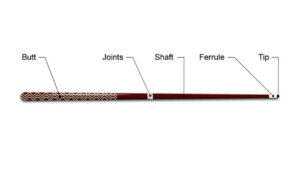Billiard Pool Cue Construction

Billiard Pool Cue Construction.
American Pool Cues.
The body of an American cue is principally made out of a lighter maple wood. Because the balls used are heavier, they require a more robust cue, which is why the Pool Cue Construction of the American pool cue is around 58 inches in length with a larger tip at 13-14 mm suitable for the larger cue ball.
Eight Ball Pool Cues.
These cues tend to be the thinnest-bodied cue at around 57 inches in size, with the smallest tip normally measuring about 8-9 mm wide. The wood used in the cue’s construction is typically ash, which is what gives English cues their noticeable grain.
Snooker Cues.
Snooker is a different kind of billiards game, and so is the cue. They’re made of ash wood, which is strong, straight, and stable enough to deliver a great performance. The length of a snooker cue is about 57-58 inches, with a tip diameter of 9-10.5mm.

Features.
Butt: The tail of the cue stick where most of the weight is distributed. The butt is where most of the weight of the cue will be distributed. Adjusting the amount and distribution of this weight is what gives the cue its ‘feel’. High end cues will have interchangeable, or adjustable weight systems inside.
Joints: Connects the butt and shaft together. The joint is the threaded, screw or ‘radial’. The joint extends forward from the joint end of the butt and screws into the joint end of the shaft to hold the two pieces tightly together. There are faster, ‘quick connect’ systems that attach and release with fewer turns, but most pros will tell you they prefer the screw for the most consistent shot.
Shaft: The upper part of the cue stick. The shaft of the cue is a length of tapered maple wood. The taper is a constant change in width from the narrow tip, to the wider collar the other end. The taper is designed to produce a consistent stroke throughout the range of motion.
Ferrule: The cuff that holds the cue tip together and reduces the impact on the shaft once the ball is hit. The cue tip is attached to the Ferrule. The ferrule protects the tapered shaft from the impacts of billiards while holding the tip in place, as well as limiting vibration. Ferrules were traditionally made of ivory. Today a ferrule is made of carbon fiber composites, or high impact plastics.
Tip: The topmost part of the cue stick used for hitting the balls. Where the rubber meets the road, or actually where the leather meets the ball. This is what will actually strike the cue ball. It is typically (though not always) made of leather and is 9-14 millimeters in diameter. Cue tips vary both in hardness, and radius.
